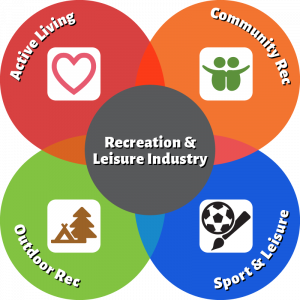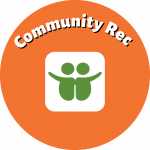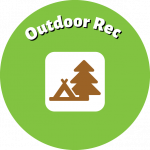Chapter 1: Recreation and Leisure Becomes an Industry
1.5 The 4 Areas of the Recreation and Leisure Industry
 This job-focused model recognizes organizations that include recreation or leisure roles in their operations and classifies them under 4 Areas (Active Living, Community Recreation, Amateur/Recreational Sport and Leisure, Outdoor Recreation and Parks).
This job-focused model recognizes organizations that include recreation or leisure roles in their operations and classifies them under 4 Areas (Active Living, Community Recreation, Amateur/Recreational Sport and Leisure, Outdoor Recreation and Parks).
The model amalgamates these organizations into the Recreation and Leisure Industry.
As an example, by this definition, from all the organizations under the Active Living Area only organizations with recreational or leisure roles/functions would be included in the Recreation and Leisure Industry. This is represented in the Recreation and Leisure Industry model diagram.
To better understand this model, let’s look at each Area in more detail.
The Active Living Area
The Active Living Area is defined as organizations that offer services focused on improving and maintaining healthy living. These organizations are found in the Healthcare, Wellness and Fitness industries and can range from Stroke Rehabilitation to Addiction Recovery to Yoga Retreats. Organizations under this Area that use recreation to enhance overall health or well being of individuals, groups or communities are included in the Recreation and Leisure Industry.
The World Health Organization (WHO) identifies five key aspects of well-being: physical, social, emotional, cognitive, and spiritual. Physical well-being includes cardiovascular health, strength, flexibility, and balance. Social well-being involves interacting with others, sharing interests, and building friendships. Emotional well-being is about managing feelings, boosting self-esteem, and reducing stress. Cognitive well-being includes thinking, problem-solving, and memory skills. Spiritual well-being involves inner peace, life satisfaction, and coping with life’s challenges.
Recreation programs are designed to enhance these areas. Physical activities improve strength, mobility, and overall health. Social activities encourage interaction, optimism, and reduce loneliness. Emotional activities boost self-esteem and help manage stress. Cognitive activities enhance thinking and memory skills. Spiritual activities promote reflection and finding meaning in life.
Therapeutic Recreation (TR) is a specialized field within the broader Recreation and Leisure Industry – Active Living Area and is gaining recognition within the health care community as a valuable and essential specialization therapy. TR uses recreational activities to help individuals with special needs improve their quality of life, addressing all five key aspects of well-being. Activities are goal-oriented, meaningful, satisfying, and offer opportunities for mastery. TR professionals work in various settings, including hospitals, treatment centers, correctional facilities, rehabilitation centers, long-term care facilities, and community programs. They are supported by Therapeutic Recreation Ontario (TRO) and the Canadian Therapeutic Recreation Association (CTRA).
The wellness economy is growing globally, with an increasing population focused on fitness, healthy eating, stress reduction, and mental wellness. In Canada, the wellness economy is valued at $128 billion, with significant contributions from physical activity, wellness tourism, mental wellness, and workplace wellness. (Global Wellness Institute, 2023)
The Community Recreation Area
The Community Recreation Area are organizations that provide community-based spaces and programming. These organizations can be public, like municipal community centers, or commercial, like East Park London and The Factory.
Community recreation and parks departments are a municipal jurisdiction in Ontario, however, they are supported financially and in other ways by all 3 levels of government. Municipal recreation includes supplying programs, services, and facilities, and managing activities like facility rentals, programming, and park maintenance. These departments often vary in name and in how they are organized in the differing municipalities or regions.
Most people in Ontario believe that parks and community recreation are important for a good quality of life. As businesses want desirable communities to attract a talented workforce and local governments are elected to meet their communities’ needs and wants, community recreation is highly coveted and a source of stable employment. Unfortunately, it is also badly underfunded, as transportation (streets and transit), water and sewer, and waste collection all take municipal budget priority over recreation and parks. This has given rise to the commercial growth in this Area and, more recently,y to public/not-for-profit partnerships.
Working in community recreation means being creative and maximizing your resources.
The Amateur/Recreational Sport and Leisure Area
The Amateur/Recreational Sport and Leisure Area are organizations that offer sporting and leisure activities (excluding professional athletes, musicians, artists etc). These organizations include community and provincial sport organizations, leisure organizations, cultural organizations, and commercial entities.
Tourism is a major player in Canada’s leisure and recreation industry in this Area. The tourism industry involves various sectors, primarily commercial, but also includes public and non-profit organizations. One specific area of tourism that creates jobs for recreational professionals is events and festivals. Events and festivals can range from sporting to cultural to business happenings. Examples include the Parks and Recreation Ontario annual conference and the World Junior Hockey Tournament. The economic impact of festivals and events is significant, supporting thousands of jobs and generating substantial revenue.
Provincial sport organizations and multi-sport organizations in Ontario serve millions of members, including athletes, coaches, officials, and administrators. Community sport clubs are increasingly hiring professional staff due to their growing size and complexity.
Whether your interest is in is history and culture, music, arts or sports, there are interesting and fulfilling career opportunities in the Amateur/Recreational Sport and Leisure Area.
Outdoor Recreation Area
The Outdoor Recreation Area are organizations that provide outdoor spaces and activity opportunities in outdoor spaces. Different sectors provide outdoor recreation services, including government, not-for-profit, and commercial organizations. Commercial services include resorts, outdoor equipment stores, and ecotourism adventures. The public sector manages parks and natural spaces, while not-for-profit organizations commonly focus on conservation and education.
Outdoor recreation offers numerous benefits, such as fostering a connection with nature, offering challenges with a sense of achievement, promoting physical exercise, enabling family bonding, and offering a place for rest and relaxation.
Jobs in outdoor recreation include roles in camping, visitor services, research, and interpretive programs. These positions help people enjoy and learn about nature while ensuring its protection for future generations.
The 4 areas of the Recreation and Leisure Industry can be further broken down into organization types and job titles that are associated with those organizations.
 Active Living – Health, Wellness and Fitness
Active Living – Health, Wellness and Fitness
Organizations that offer services focused on improving and maintaining healthy living. The examples listed are found in London and/or Ontario region.
| Types of Organizations | Examples |
|---|---|
| Community service organizations |
|
| Health related organizations |
|
| Educational organizations |
|
| Corporate fitness services and facilities |
|
| Long Term Care and Retirement Residences |
|
| Manufacturing, retail, and wholesale trade related to active living (e.g. swimming pools, home-based exercise equipment, active apparel etc.). |
|
 Community Recreation
Community Recreation
Organizations that offer community-based spaces and programming. The examples listed are found in London and/or Ontario region.
| Types of Organizations | Examples |
|---|---|
| Public and community-based organizations, spaces, and centres that offer active and passive recreation opportunities |
|
| Commercial organizations that offer recreational opportunities |
|
| Manufacturing, retail, and wholesale trade related to community recreation (e.g., suppliers of playground equipment, etc.). |
|
 Sports and Leisure
Sports and Leisure
Organizations that offer sporting and leisure activities, excluding professional athletes, musicians, artists etc. The examples listed are found in the London and/or Ontario region.
| Types of Organizations | Examples |
|---|---|
| Community and Provincial sport organizations |
|
| Community and Provincial leisure organizations |
|
| Non-profit and Commercial offering access to sport and physical recreation to the public |
|
| Community and Provincial cultural organizations (museums, heritage sites, community theatres, community orchestra and music organizations) |
|
| Manufacturing, retail, and wholesale trade related to amateur sport and leisure pursuits (e.g. equipment manufacture, sales, rentals, etc.). |
|
 Outdoor Recreation and Parks
Outdoor Recreation and Parks
Organizations that provide outdoor spaces and activity opportunities in outdoor spaces. The examples listed are found in the London and/or Ontario region.
| Types of Organizations | Examples |
|---|---|
| Public, voluntary, and commercial parks, open spaces, and facilities for individual and group involvement in active and passive outdoor pursuits (e.g., picnics, hiking, camping, climbing, rafting, etc.). |
|
| Guides and outfitters |
|
| Provincial Recreation Associations |
|
| Tourism-related organizations around outdoor recreation & parks |
|
| Manufacturing, retail, and wholesale trade related to outdoor recreation and parks (e.g., camping equipment, recreational vehicle trade - snowmobiles, RVs, etc.). |
|

